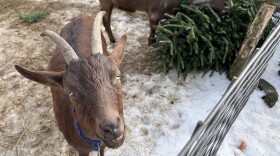So, this partnership among NHPR, New Hampshire Audubon and the Society for the Protection of New Hampshire Forests is one in which bird and tree knowledge is well represented. But much of the state’s wildlife, as you’ve no doubt noticed, can be classified as “other.” Today we tackle some of that other, in the form of the garter snake with Mike Marchand, Wildlife Biologist with N.H. Fish and Game.
There are about a dozen different species of snake in the granite state, but chances are if you’ve seen a snake in New Hampshire, it was a garter snake. They are the most common variety of snake here. Partially because they are not particular about their habitat. “I’ve seen them on the seacoast, in the city, even at 4,000 feet in elevation at Mount Isolation,” says Marchand.
Snakes, like all reptiles, are cold-blooded, which presents challenges when living in a northern climate like New Hampshire. “When it’s warm reptiles tend to be really active, and when it’s cool they tend to slow down. When fall comes around “they start looking for suitable places where they cannot freeze, that might be rocky substrate [editor's note-he means an area of land that's made up of mostly rocks], a rotting log, or even an ant mound.” All of New Hampshire's snakes seek shelter underground, though, "Garters are more cold tolerant than most snake species and can freeze for short periods of time, but if that freezing is an extended period of time they can die.”
What are they doing now in spring? They’re emerging from their underground winter hibernacula, which are often communal so you might come across a tangle of many garters writhing together. They may simply be writhing together to consolidate body temperatures, or it could be the other reason we animals writhe together. As Marchand points out, this time of year, “they’re starting to look for food and mates.”
We’ve been kicking around a few vocab words in the Something Wild pen recently; viviparous, which is of course the act of giving birth to live young; oviparous, a strategy in which the female lays eggs that contain the young. But we also came across ovoviviparous, which seemed a contradiction at first blush, but as it turns out, is a strategy employed by our garter snakes. In this case, the embryo develops inside an egg, but the egg stays inside the female until hatching; so young garters are born shortly after they hatch. Marchand explained that these young are drawing nutrients from a yolk sack, where their viviparous counterparts are fed from a placenta.

“The stereotypical form of the garter snake, they have three yellow stripes, one on the top and two on the sides.” It makes them resemble a gentleman’s sock garter, which is how they received their common name. But, “they often don’t have the stripes, they can have checkerboard pattern.” NH Fish and Game even had a confirmed report of a melanistic (or all black) garter.
Marchand takes issue with the notion that these snakes are vicious. “Any animal is going to do what they can to protect themselves. I challenge you to catch a blue jay and see what it does to you.” He’s been bitten but, the wound is no worse than a scratch from a stray thorn. He argues that they can be valuable allies, “Garters eat a variety of small prey, some of those species are considered pests for gardens.”
They’re generalists, which means they’ll eat anything they can fit in their mouth from slugs, salamanders, grasshoppers, etc. After they track down and capture their prey, they put those teeth of theirs to work. They hold onto the prey to prevent it from escaping, it also creates wounds into which their saliva can seep. Garters don’t have venom, but recent research suggests their saliva does contain a neurotoxin which immobilizes their prey as they consume and digest it.








